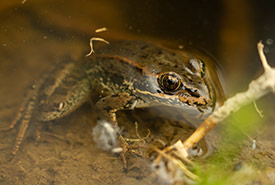
Northern red-legged frog (Photo by Fernando Lessa)
Northern red-legged frog
Amphibians are essential for both water and land ecosystems. Frogs are just one of the many amphibian species that call wetlands home, which is why the Nature Conservancy of Canada (NCC) is working to protect habitat for the northern red-legged frog.
What does this species look like?
Despite its name, the northern red-legged frog’s legs are not completely red. Rather, its hind legs have translucent red undersides. This frog is small — around 7 to ten centimetres in length, and it is mostly reddish-brown and black-speckled; perfect for blending in with mud and grass to avoid predators.
The northern red-legged frog is very similar in appearance to the Oregon and Columbia spotted frogs in size, shape and colour. It can be challenging to differentiate them especially as their appearance changes in various life stages; however, there are subtle ways to tell them apart. The northern red-legged frog’s eyes face to the side, whereas the eyes of the Oregon and Columbia spotted frog turn upward and can be seen from above. The spotted frog's hind feet have webbing all the way to the tips of their toes, whereas the northern red-legged frog’s hind feet webbing does not.
Where does this species live?
In Canada, these frogs can be found along the Pacific Coast in southwestern British Columbia, mainly on Vancouver Island and the Gulf Islands. This species can also be found in wetlands in the Greater Vancouver Area. During breeding season, northern red-legged frogs use a variety of aquatic habitats, including ponds, marshes, lakes, slow-moving streams and even ditches, to name a few. The most important habitat features for northern red-legged tadpoles includes a variety of vegetation in the wetlands and submerged downed wood. These features help tadpoles hide from predators and they also keep water temperatures cool. Once mature, these frogs are typically found in moist, cool forests where there is plenty of leaf litter and downed wood to take cover under. In hot summer months, adults can be found along streams and wetlands.
What is this species’ conservation status?
The Committee on the Status of Endangered Wildlife in Canada has assessed the northern-red legged frog as special concern. The northern red-legged frog’s population has seen significant losses in numbers in parts of its range in BC and is at risk of disappearing from some locations due to a variety of reasons, including habitat loss and degradation.
What is NCC doing to protect habitat for this species?
NCC restored a 2.6-hectare (6-acre) wetland from an old agricultural field on Chase Woods Nature Preserve. The project broke ground in 2018, and monitoring results in 2020 showed that many species that were previously not sighted began to use the restored habitat, include northern red-legged frogs.
NCC also works alongside the Wetlands Workforce, a large-scale, collaborative project that monitors, manages and restores wetlands across the province.





